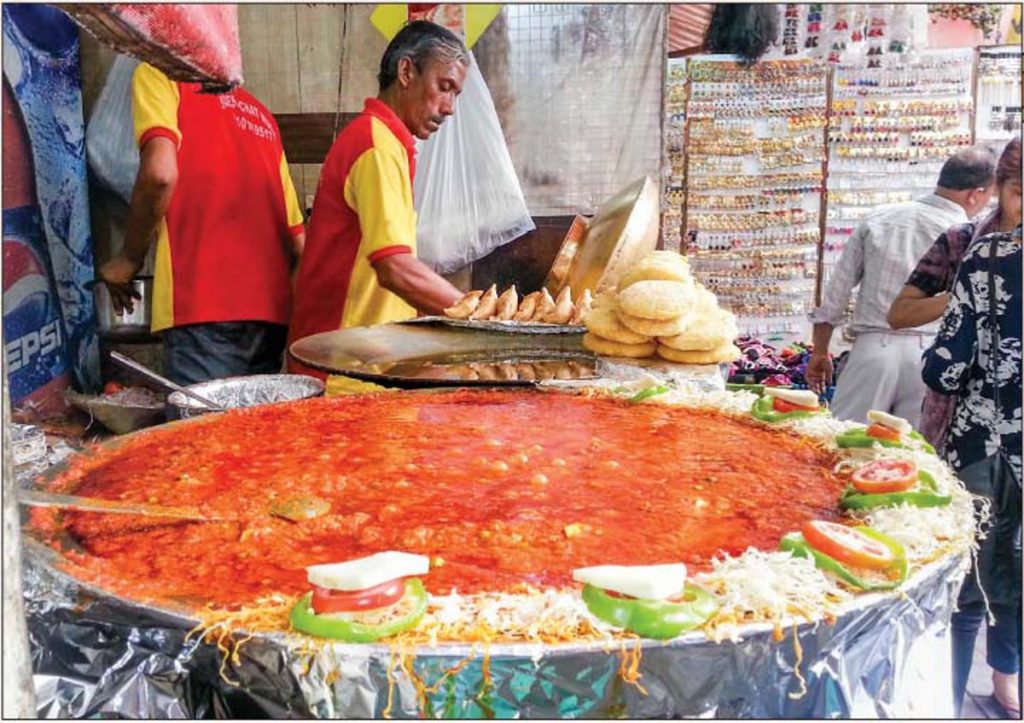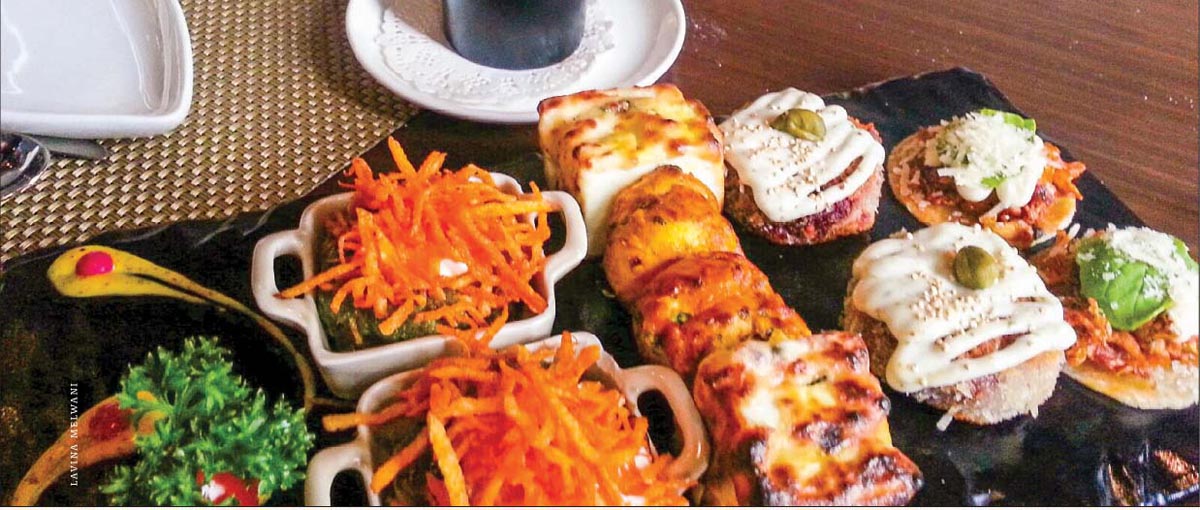With its history of culinary arts and broad range of regional styles, India offers a dazzling cornucopia of choices for vegetarian foodies
By Lavina Melwani, Delhi
In India, it’s all about food—and if you are vegetarian, India simply has no comparison. As a traveler from the prosaic West and eater of quick sandwich meals, I was delighted that my return journey to Delhi, the capital of India, brought me to the fabled magic table of remembered childhood where you have to merely clap your hands to get undreamed of delicacies. Even before taking flight, you can order a vegetarian or vegan meal. And once you land, no mere salad, pizza or boiled veggies here—the complex dishes that appear on the dining table are deliciously intricate, from Rajasthan’s Ghatte Ke Curry (chickpea flour dumplings) to the Punjab’s Besan Koftas (dal flour balls in yogurt gravy).


As a toddler, I remember our family cook Shankar, who used to work on a coal oven in the open courtyard and hand-feed us hot, simple sabzis (veggies) with fresh rotis while telling stories from the Ramayana. Those tastes linger after decades, as does the taste of Sindhi channa dabalroti—chickpeas simmered in a golden gravy made from chick pea flour and served over slices of bread, with a topping of sliced onions and crispy flakes, or murmula. This was served to friends who came to our home to view the grand Republic Day Parade which passed below the balcony of our apartment in Connaught Place every year.
Yes, food was always an intrinsic part of our outings—be it plates of alu tikkis (potato turnovers) or aromatic chole bhature (chick peas and flatbread) and plump, syrupy gulab jamuns at roadside stalls. Delhi is famous for its chaat shops, fiery ammunition centers that scorch your tongue and make you weep with pani puri, bhelpuri, gol gappas, and samosa chaat (fried flatbread and veggie ball snacks with sauce.)
Then there were the visits to Old Delhi, my father’s go-to destination for a special hundred percent pure pista mithai. Seems at the age of four, I would eat only this rich, dark green pistachio sweet and my dad which Dad would sometimes make special trips to get for me.
If happy occasions involved food so did sad ones. There was the season of shraddas—meals commemorating the departed—when carloads of uncles, aunts and cousins would descend on the home for prayers and feeding the pujari the delicious treats the ancestors had loved. Then we, too, would feast on the wonderful food. There was Sindhi curry and rice, saibhaji—spinach cooked with seven vegetables, pakoras and samosas, daibhallas and, of course, all followed by gulab jamun and jalebis (fried orange pinwheels). Each part of the extended family would bring their own special dishes, and it would be an endless talkathon and eatathon. With so many uncles and aunts around, life meant a lot of feasting after the holy days’ fasting.
So I returned this year to an India exploding with food memories. The first morning in Delhi at my sister’s home, it was as if nothing had changed. We had Sindhi kokies for breakfast, flatbreads embedded with chopped onions and green chilies, and served with yogurt. It was hard to stop at one, and brought back memories of mothers, grandmothers, loved aunts—all who had served this must-have breakfast.
As the families have grown and children married into different households in different regions of India, new recipes have entered the repertoire, as well as Western dishes that have become popular in affluent India. On the menu might be a noodle dish one night and a Thai soup the next, while pizza and pastas are not unusual foods at home. A Sindhi sister-in-law, who is Sindhi but grew up in Indonesia, served us a dinner of gado-gado (salad of blanched vegetables, tofu or tempeh), noodles, nasi goring (fried rice) and other treats—all vegetarian, since she is a Sai follower.
Perhaps the greatest treats on my visit were those served at home by the family cook. Chillas delicious crepes made of mung daal, served with guar and achari aloos and chutney. My sister had different food for me on the table every day, including that made by a Brahmin cook who makes vegetarian food only and uses no garlic or ginger.
Since everyone in my family circle has access to great cooks, there was a lot of animated food exchange going on. Dahi ki sabzi is a delicious treat I had never experienced, a dish made with thick, Greek-style yogurt, vegetables and condiments. Another unusual dish was tawe wale chawal (a type of vegetarian fried rice).
Super strict vegetarians can find hundreds of shudh restaurants all over Delhi, places that do not prepare meat of any kind on their premises. Many other fine restaurants are “vegetarian friendly,” offering marvelous fare for those less concerned about what else goes on in the kitchen. Either way, vegetarians in India have an unimaginable array of choices.
If money is no concern, just about anything is possible, with a buzzing world of five-star hotel restaurants. I visited a fancy new place called Delhi Club House—a take on famous old clubs like Calcutta’s Tollygunge Club and the Royal Bombay Yacht Club and their signature dishes. The menu includes famous delicacies like cheese Bombay toastie (at the Presidency Club), vegetable momos (Gorkha Rifles Mess) and Saffron Onion Rice (Railway Club).
Delhi’s mall culture has posh restaurants as well as fast food places. Brand names from America are all here, from Subway and Dominos to TGIF. McDonalds, for instance, offers varied vegetarian alternatives that you don’t find in the US, including Mexican and Lebanese McAloo Tikki, Crispy veggie pops and Paneer Salsa Wrap.


While America has brought Burger King to India, an enterprising desi trio have come up with Burger Singh, serving craft burgers with a sense of humor and a distinctly Indian touch. Vegetarian burger lovers also have many options, starting with Nani’s Rajma Burger (Grandma’s bean burger), United States of Punjab Veg Burger, Chana Burger and Shorshe Paneer Burger.
Even middle class India is on a big “eating out” journey. Global Indian food giant Haldirams, established in 1937, with revenues higher than McDonalds and Dominos combined, has outlets throughout Delhi and all over India. Many offer a modern, food-court, self-serve interior and provide savory, hygienic food at good prices. These and other small restaurants are everywhere, serving tasty, robust street food in a sanitized atmosphere, handled with gloves—and with chutneys made with bottled water—no risk of “Delhi belly” here!
Regional cuisine is offered in scores of restaurants, from Gujarati to South Indian. Swagath, in the Defence Colony Market, has the most marvelous dosas and a big screen TV where fans enjoy the games when cricket fever hits. This seven-chain restaurant serves Mangalorean, Malvani, Goan, Chettinad, Gomantak and Andhra cuisine. Elsewhere, you can get everything from Bengali to Tibetan food, and with many vegetarian variations.
Vegetarians comprise 30 to 40 percent of Indians, a large market that gets special attention. Even Chinese and Thai restaurants have strong vegetarian components. The menu for Berco’s, a Chinese and Thai eatery in Delhi, even states, “All dishes can be made without onions and garlic—just let us know!”
During my 45-day stay in India, I enjoyed virtually every possible kind of meal, from gourmet to street-fare to home-cooked comfort food. What stays most in my memory is a grand Holi celebration at a friend’s house where all the food was created by traditional chefs from Mathura, home of Lord Krishna. Guests played with colors and danced to the music to celebrate the festival of colors. The hosts had created a colorful marketplace with a vegetarian feast of specialties from this pilgrimage spot, all served on metal plates and in clay pots. The menu included everything from malpuras (sweet bread) to pakoras (batter-fried vegetables), vada pav (lentil paddy) and ragda pattis (potato turnovers) to main courses, including paneer ki khurchan (spiced soft cheese) and kulfis, ice cream, of many flavors served in little clay pots. There were mounds of jalebis and multicolored mithai. Fresh puris made of green peas were fried on the spot. The bhel puri was served in playful multicolored buckets, in keeping with the Holi spirit. It was a vegetarian paradise with unimaginable treats—and all cooked with pure ghee.
Yes, in India, if you can dream it, there are skilled hands that can make it happen!
Lavina Melwani is a journalist who writes for several international publications. She blogs at Lassi with Lavina.
lassiwithlavina.com Follow @lavinamelwani


